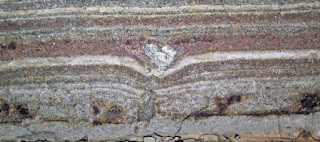Forcing Another Cold Period in the Neoproterozoic Era
In this rather technical piece, it is clearly seen that some secular geologists are making a case using not only broad presuppositions, but with very little evidence as well. Biology has a taxonomy hierarchy of seven levels, geology also has divisions: Eon, era, and period. From these we get about thirty-five words to work with.
The Neoproterozoic is one of three eras in the Proterozoic Eon. This supposedly lasted millions of years by secular reckoning. Certain rocks and their placement in geologic layers are used to signal the existence of ice ages.
 |
| Dropstone in sediment image by James St. John at Flickr (CC BY 2.0) |
By assuming evolution to support evolution, secularists conveniently limit the explanations for the five (really, is that all you have?) alleged dropstones found in Scotland. Those supposedly provide evidence for glaciation, but that scenario doesn't fit very well here, and there are other interpretations that should be considered. The explanation that best fits the evidence is a creation science Genesis Flood model. However, the author of this article states that more research is needed.
There are three main diagnostic indicators used to support ancient ice ages1 that are supposedly hundreds of millions to billions of years old. These indicators are striated and faceted rocks, striated bedrock, and dropstones in varvites. Faceted rocks have been ground down by friction to a flat surface, presumably by glacial movement. A dropstone is a rock that is larger than the containing layers, while varvites are believed to be lithified varves—rhythmites believed to have been laid down in one year. Rhythmites are regularly repeating laminae of two or more lithologies. Striated bedrock is solid rock typically underlying unconsolidated surface materials that has small (often parallel) grooves scratched into its surface.
You can read the rest of the article at "Do five dropstones define another Proterozoic cold period?" Since the alleged rocks were found in Scotland, here is some Scottish rock: